By Jeffrey A. Rendall, Photos by David Vier
HILTON HEAD ISLAND, SC – Have you ever been someplace and thought, ‘I’m sure I’ve been here before, but it looks nothing like what I remember’?
If so, you could experience a very similar feeling upon visiting Heron Point by Pete Dye, a relatively “new” golf course on Hilton Head Island (part of The Sea Pines Resort). To put it simply, Heron Point replaced the old Sea Marsh golf course in the same location, and there aren’t many points of reference to what was there before.
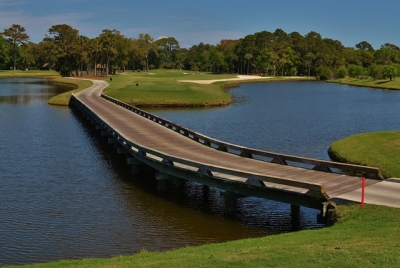 |
| Pete Dye usually offers an easy tee shot on the first hole of the day, but not at Heron Point. |
For occasional visitors to Hilton Head and admirers of its golf product – which of course includes the famous Harbour Town Golf Links – you may be in for a bit of a shock when you sign up for a tee time at Heron Point. Make no mistake; it’s a good kind of surprise, but a bit startling nonetheless.
Heron Point shares the same clubhouse facility with the Ocean Course, which was also redone (by Mark McCumber) in 1995. About ten years after the Ocean Course was reopened, it was time to focus on Sea Marsh -- and this is where Pete Dye enters the picture.
Cary Corbitt, Vice President, Sports and Operations for Sea Pines Resort, takes the story from here. “The old Sea Marsh golf course was a George Cobb design that opened in 1963. After we redid the Ocean Course, we realized that something needed to be done with Sea Marsh as well.”
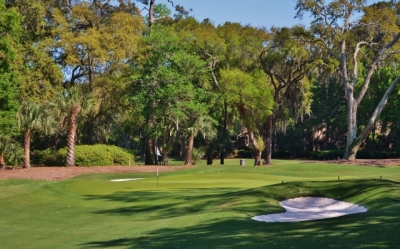 |
| Small green targets are the norm at Heron Point. Here, the par four 12th. |
Corbitt continues, “The drainage had gotten to the point where it wasn’t functional. The grasses on the course were nothing like the hybrid grasses of today that have been introduced throughout the industry. And the greens were in need of new grasses and being rebuilt.”
“The entire golf course was just old and outdated and needed a fresh start and to put new character into the golf course.”
The evolution of turf technology is causing a lot of golf course owners to realize the same thing. You may remember Harbour Town Golf Links itself used to be known as a golf course that was in great shape for one month a year – April (just in time for the Heritage Classic) – but offered rough conditions most other times because of the difficulty of growing turf in Hilton Head’s demanding climate.
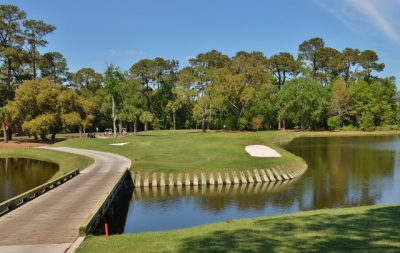 |
| The 239-yard 4th is the first of a very challenging set of par threes. |
Harbour Town underwent an upgrade, and now it’s in great shape most of the year.
We remember Sea Marsh as a pleasant stroll through the Sea Pines residential community, complete with your standard water hazards, plenty of sand and not a whole lot of challenge.
It was a good place to go if your confidence needed a little boost from being beat up by much tougher tests of golf.
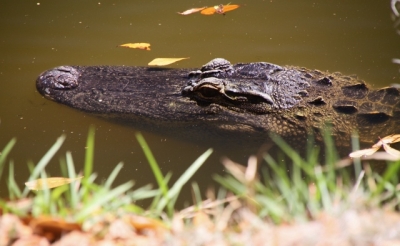 |
| Think twice before trying to fish a ball out of the lagoons at Heron Point. |
Pete Dye not only redid the golf course, he also gave it teeth. Dye was forced to use the existing hole corridors, but there’s little else you might recall from Sea Marsh.
It’s a completely different golf course.
“Pete was pretty much given carte blanche as far as making a golf course that’s challenging,” Corbitt explained. “He did not want to have a replication of Harbour Town Golf Links, with cross-ties and such. So we introduced kind of a laidback wall in lieu of cross-tie walls.”
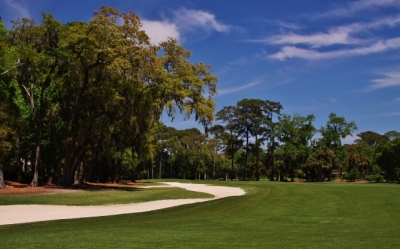 |
| Looking back towards the tee of the par four 5th hole. A long bunker and overhanging tree guard against trying to cut the corner. |
“There’s also a lot of movement in the fairways unlike Harbour Town, which is pretty well flat and right in front of you. Similarly, there’s a lot of movement around the greens -- and the traditional Pete Dye greens complexes, being small in size, were certainly part of what Heron Point has come to be.”
Heron Point’s greens are indeed small by today’s standards, with the average size being around 3800 square feet. That’s enough room to provide both challenging and easier pin placements, but small enough to ensure you’ll miss some of them on approach shots.
Therefore, there’s an emphasis on the short game at Heron Point. But you wouldn’t come to a Pete Dye course and expect to skate by without your short shot creativity, would you?
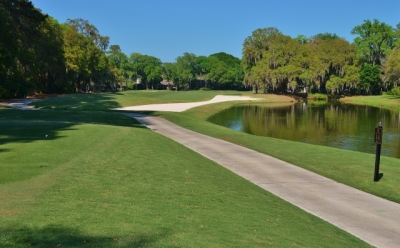 |
| The view from the tee of the par four 14th strongly suggests a fade. |
Making the approaches even harder is the aforementioned slope in the fairways. Hilton Head Island is flat as a pancake, but that doesn’t mean Heron Point had to reflect its blandness.
“Pete moved 400,000 yards of dirt to create the course’s uniqueness,” Corbitt said. “There isn’t a ton of movement in the fairways – maybe three to six degrees – but you can have a ball that’s slightly downhill, a couple inches below your feet or a couple inches above.”
“You’ll have to take those things into account in terms of the type of shot and accuracy of club selection,” Corbitt added.
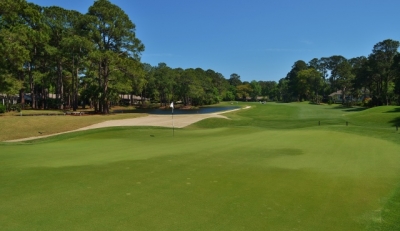 |
| The short par five 9th is still a three-shot hole for almost everyone. |
There’s also additional length to contend with on Heron Point as compared to Sea Marsh. Heron Point’s Heritage tees stretch out to 7058 yards, and pack a punch with a 75.2 course rating and 141 slope.
You won’t find the same tee shot placement challenges of Harbour Town Golf Links, but there’s still plenty to keep you busy. It’s a tough golf course.
Naturally, Heron Point can also be played at distances that are much gentler. The ‘Family’ tees measure 3700 yards and take out all the carries, so you can bring kids and beginners out, too. The white tees (Sea Pines tees) come in at 6045, just the right length for a pleasant resort golf experience.
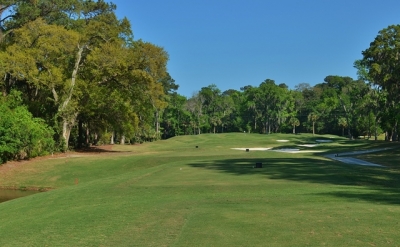 |
| There is no easy way to attack the long and challenging par three 16th hole. |
With the course completely lined by mature trees, the driving corridors are tight in spots – or at least narrow enough to cause some discomfort for people who curve the ball a lot. Dye typically leaves enough room to land your tee shots, but be mindful of the most strategic side of the fairway – and then hit it.
Heron Point’s fairway bunkers are deep enough to be a real penalty, another element of strategy that Dye mixes in.
A player-friendly aspect of the course is its walkability. The nearness of greens and tees as well as the generally flat topography makes it a pleasing stroll on a nice day. To that end, there are caddies (and forecaddies) available to tote your bag. The level of service is exactly what you would expect from a high-end resort.
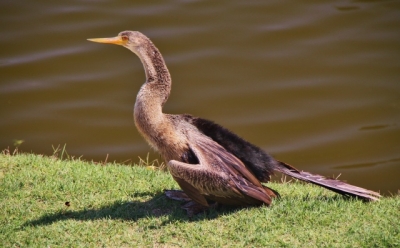 |
| Wildlife abounds at Heron Point. |
A final note before examining a few of Heron Point’s highlight holes -- a trip around the golf course is also a trip through nature. True, virtually the entire layout is bordered by houses, but there are plenty of living creatures to be found just about everywhere you gaze (Heron Point is a Certified Audubon Sanctuary).
Look around and you’ll see egrets, heron, ospreys and turtles. Then there are the alligators. The toothy reptiles seem right at home with all the golfers and homeowners. I’m told that if they grow too large that they’re relocated to ‘safer’ environs – but you’ll still see all you want to see.
Highlights at Heron Point include the par three fourth hole, a one-shotter with a classic Pete Dye appearance. The green is bordered by water on the right, and there’s a bailout shaved chipping area to the left. In addition to the water, the hole plays 239-yards from the back tees, so it’ll require distance and accuracy to make a score here.
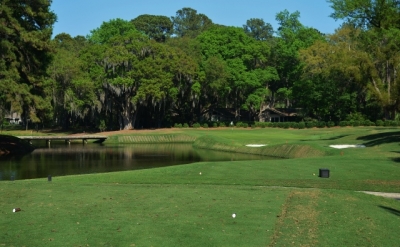 |
| The 157-yard, par three 13th is the shortest hole on the course, but there is still plenty of trouble to contend with. |
The par five ninth is very unique. It’s relatively short for a par five – 519 yards from the Heritage tees – but it’s likely a three-shot hole for everyone but the pros. The hole doglegs sharply left from the tee shot landing area, so you may not need driver off the tee (it won’t give you much of an advantage). After choosing your layup area, the third shot is into a narrow green with mounds in front and a bunker to the right.
Moving to the back, the view from the tee of the par three sixteenth is pure intimidation. No water on this hole, but it’s another long one – 233 yards from the back tee – and there are mounds and sand guarding just about every angle. Most of the sand shouldn’t come into play (it’s short of where the ball should land), but it messes with your mind on the tee shot.
The closing par four eighteenth is a familiar site on Pete Dye courses. Students of the architect note that he usually includes water down the left side of his finishing holes – and Heron Point’s is no different. Complicating the tee shot is a large bunker and grassy mounds to the right of the tee shot landing area. There’s nowhere safe but the fairway here.
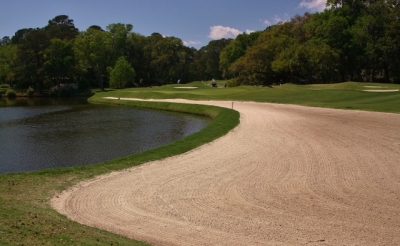 |
| Pete Dye often uses bunkers to keep balls from reaching the water. Here, near the green of the par five 6th. |
The second shot calls for a high and long approach. There’s a large pot bunker short and right of the putting surface and water to the left. You’ll earn your par on the last green at Heron Point.
As mentioned previously, the service at Heron Point is worth commending. With two golf courses and heavy play, the staff is well trained in getting people where they need to go with a smile on their face and some gentle reminders.
The practice facilities are also excellent, with a natural grass range and large putting and chipping areas.
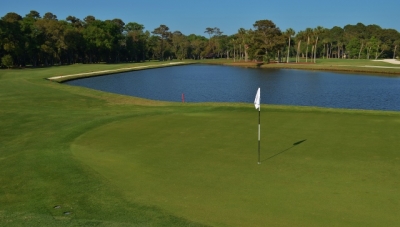 |
| After the final putt on the par four 18th hole, you will agree Heron Point is Hilton Head golf at its finest. |
Heron Point by Pete Dye is an all-around great experience. It’s a nice complement to Harbour Town Golf Links, adding another Dye classic to the Pete Dye lineup at the resort. There are many golf courses to choose from on Hilton Head (and in the surrounding area), but Heron Point ranks up there with the best the region has to offer.
(Note: Heron Point will reopen from the recent renovation on September 22, 2014. Dye's team softened the green surrounds and contours, enlarged several greens, and added ornamental landscape beds throughout the layout. The putting surfaces were transitioned to Tif-Eagle Bermuda, the same strand used on Harbour Town Golf Links.)
Details:
Heron Point by Pete Dye
100 North Sea Pines Drive
Hilton Head Island, SC 29928
Phone: (800) 955-8337; (843) 842-8484
Website: www.Seapines.com
PGA Director of Sports: Cary Corbitt
PGA Head Golf Professional: Bobby Downs
Superintendent: Jim Cregan
Course Architect: Pete Dye
Tees/Yardage/Slope/Rating
Heritage 7058/6935 141/75.2 (140/74.7)
Dye 6547 134/72.5
Sea Pines 6045 128/70.4 L 139/76.7
Carolina 5594 125/68.7 L 133/74.6
Palmetto 5176 112/66.4 L 123/71.6
Family 3699
Rates:
$148 in high season – a registered Resort guest is $138; $99 in the afternoon.
$102 in low season – a registered Resort guest is $98; $65 in the afternoon.
The Sea Pines Resort features renown tennis programs, beautiful beaches, 15 miles of scenic bike paths, a 605-acre forest preserve, horseback riding, Eco-Adventures, fishing excursions, waverunner rentals and more, as well as exceptional shopping, dining and nightlife at world-famous Harbour Town.
| Related Links | Comments on this article? | |
|
Maryland National Golf Club Hollow Creek Golf Club Rocky Gap Resort PB Dye Golf Club in Ijamsville Whiskey Creek Golf Club |
E-mail Jeff Rendall, Editor: jrendall@golftheunitedstates.com |











